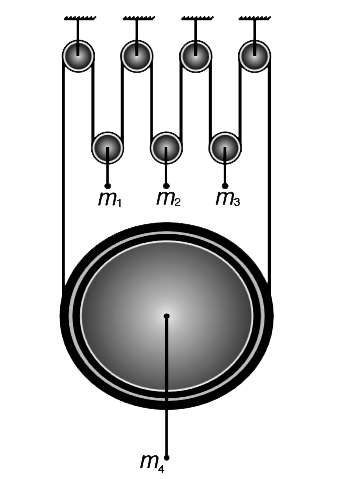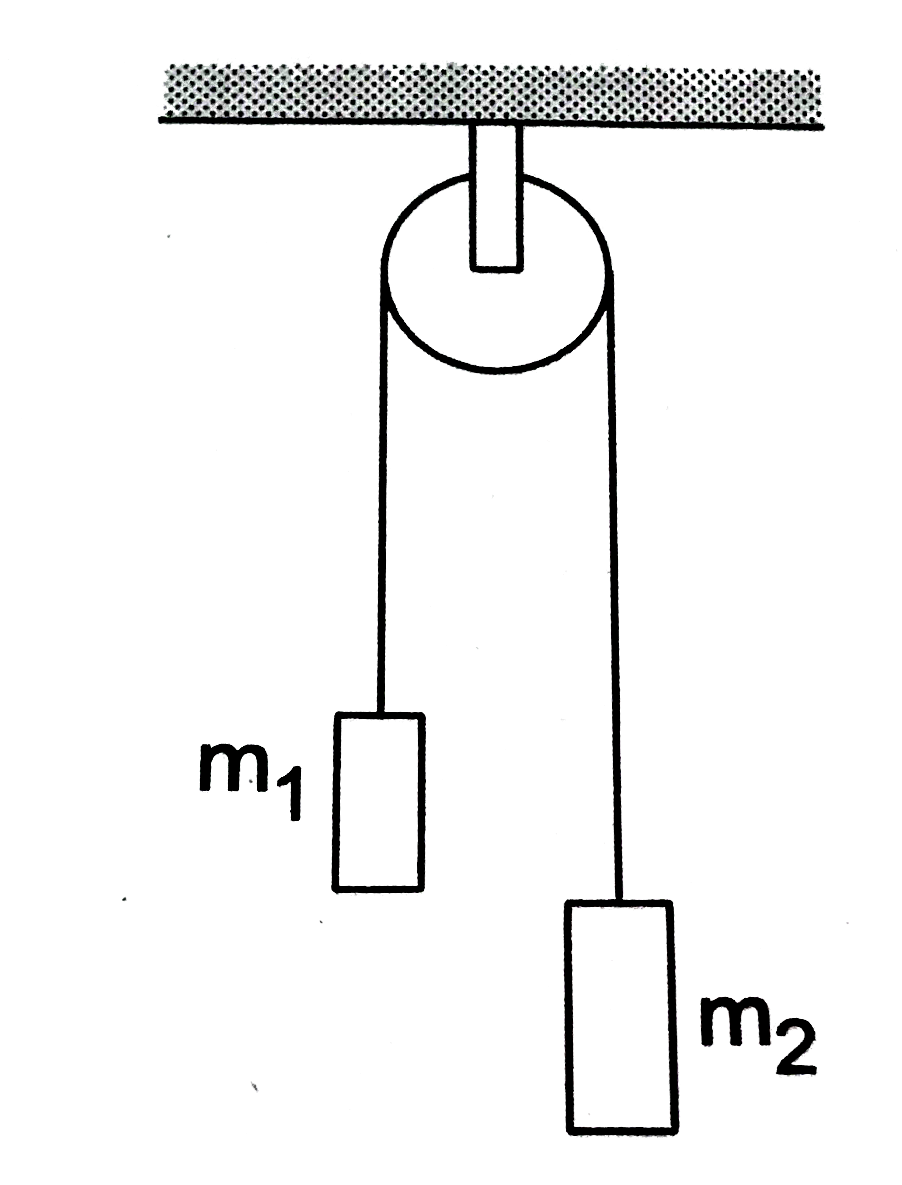Simple Atwood Machine as System of Particles
The system shown in the figure is known as simple Atwood machine. Initially the masses are held at rest and then let free. Assuming mass m2 more than the mass m1, find acceleration of mass center and tension in the string supporting the pulley.
 Solution in Gujrati
Solution in Gujrati
We know that accelarations a1 and a2 are given by the following equations.
a2=m2−m1m2+m1g⏐⏐
⏐↓ and a1=m2−m1m2+m1g↑⏐
⏐⏐
Making use of eq. , we can find acceleration ac of the mass center. We denote upward direction positive and downward direction negative signs respectively.
M→ac=Σ(mi¯ai)→ (m1+m2)ac=m1a1−m2a2
Substituting values of accelerations a1 and a2, we obtain aC=2m1m2−m21+m22m1+m22
To find tension T in the string supporting the pulley, we again use eq.(9)
Σ→Fi=M→ac→ T−m1g−m2g=(m1+m2)ac
Substituting expression obtained for ac, we have
T=4m1m2m1+m2g
Topper's Solved these Questions
- CENTRE OF MASSBOOK - ALLEN CHAPTER - CENTRE OF MASSEXERCISE - EXERCISE-I
40 Videos
- CENTRE OF MASSBOOK - ALLEN CHAPTER - CENTRE OF MASSEXERCISE - EXERCISE-II
43 Videos
- BASIC MATHEMATICS USED IN PHYSICS &VECTORS BOOK - ALLEN CHAPTER - BASIC MATHEMATICS USED IN PHYSICS &VECTORS EXERCISE - EXERCISE-IV ASSERTION & REASON
11 Videos
- ELASTICITY, SURFACE TENSION AND FLUID MECHANICSBOOK - ALLEN CHAPTER - ELASTICITY, SURFACE TENSION AND FLUID MECHANICSEXERCISE - Exercise 5 B (Integer Type Questions)
3 Videos
Similar Questions
The centre of mass of a non uniform rod of length L whoose mass per unit length varies as p=kx2/L, (where k is a constant and x is the distance measured form one end) is at the following distances from the same end
View SolutionTwo particle A and B start moving due to their mutual interaction only. If at any tiem 't', →aA and →aB are their respective accelerations, →vA and →vB are their respective velocities, and upto that time WA and WB are the work done on A and B respectively by the mutual force, mA and mB are their masses respectively, then which of the following is alwys correct.
View SolutionAssertion: If the initial and final positions coincide, the displacement is a null vector.
Reason: A physical quantity can not be called a vector, if its magnitude is zero.
View SolutionTwo soap bubbles A and B are kept in a closed chamber where the air is maintained at pressure 8N/m2.The radii of bubbles A and B are 2cm and 4cm, respectively. Surface tension of the soap-water used to make bubbles is 0.04N/m. Find tha ratio nB/nA, where nA and nB are the number of moles of air in bubbles A and B, respectively. [Neglect the effect of gravity.]
View SolutionThree blocks of masses m1,m2 and M are arranged as shown in figure. All the surfaces are fricationless and string is inextensible. Pulleys are light. A constant force F is applied on block of mass m1. Pulleys and string are light. Part of the string connecting both pulleys is vertical and part of the strings connecting pulleys with masses m1 and m2 are horizontal.

(P)Accleration of mass m1(1)Fm1(Q)Acceleration of massm2(2)Fm1+m2(R)Acceleration of mass M(3)zero(S)Tension in the string(4)m2Fm1+m2
View SolutionIn the system shown in fig., all pulleys are mass less and the string is inextensible and light.
(a) After the system is released, find the acceleration of mass m1
(b) If m1=1kg,m2=2kgandm3=3kg then what must be value of mass m4 so that it accelerates downwards?

View SolutionA system of masses and pulleys is arranged in a vertical plane as shown in Figure 5.24 her. If mA:mB:mC=3:2:1. Find their accelerations.
View SolutionFind the acceleration of masses m_(1) and m_(2) connected by an inextensible string, shown in figure-2.13(a). The string and pulley are assumed to be massless and frictionless.
View SolutionA situation is shown in figure-2.15, Find the acceleration of masses m_(1) abd m_(2) mass of pulley is m_(P) . Consider the string going over the pulley is massless and frictionless.
View SolutionTwo masses m1 kg and m2 kg passes over an atwoods machine. Find the ratio of masses m1 and m2 so that string passing over the pulley will just start slipping over its surface. The friction coefficient between the string and pulley surface is 0.2.
View SolutionIn an atwood machine the two blocks have massess 1kg and 3kg . The pulley is massless and frictionless and string is light. The acceleration of the centre of mass (in m//s^(2) ) of this system is 0.5x . Find the value of x .
View Solutionएक सरल एटवुड-मशीन में एक घर्षणरहित एवं क्लैम्प की गई घिरनी पर से जाती हुई एक भारहीन डोरी की सहायता से दो असमान द्रव्यमान m1 तथा m2 लटकाए जाते हैं | चित्र में एक एटवुड-मशीन दिखाई गई है जिसमें द्रव्यमान m1=300 g तथा m2=600 g है | इस निकाय को विरामावस्था से छोड़ा जाता है |

(a) छोड़ने के बाद पहले 2 s में द्रव्यमान m1 द्वारा तय की गई दूरी ज्ञात करें |
(b) डोरी में तनाव ज्ञात करें |
(c) क्लैंप के द्वारा घिरनी पर लगाया गया बल ज्ञात करें |
View Solutionऊपर के प्रश्न 32 में बताई गई एटवुड-मशीन में निकाय में गति प्रारंभ होने के 2 s पश्चात भारी वाले द्रव्यमान (m2) को एक क्षण के लिए रोक दिया जाता है | डोरी के पुन: तनाव में आने में लगा समय ज्ञात कीजिए |
View SolutionThree masses m1,m2andm3 are attached to a string -pulley system as shown . All the three masses are held at rest and then released If m3 remains at rest , then

View SolutionTwo masses m_(1) and m_(2) are connected to the ends of string passing over a pulley. Find the tension and the acceleration associated.
View SolutionShown in the figure is a system of three bodies of mass m_(1), m_(2) & m_(3) connected by a single inextensible light string. If all surfaces in contact are smooth & the pulleys P & Q are light, find the tension in the string.
View Solution
